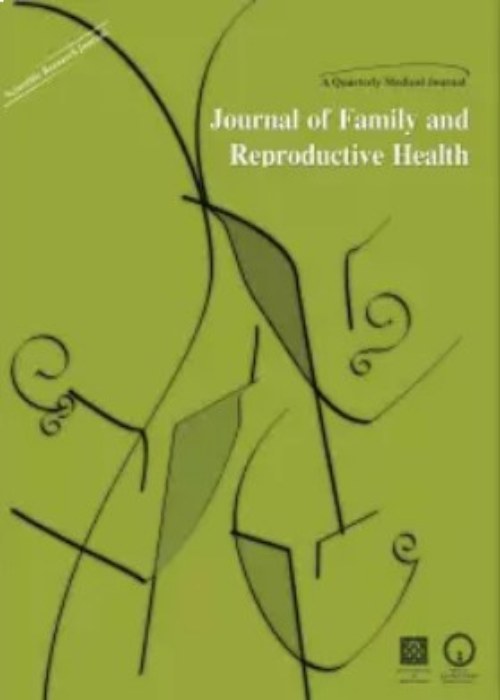فهرست مطالب
Journal of Family and Reproductive Health
Volume:5 Issue: 3, Sep 2011
- تاریخ انتشار: 1390/10/11
- تعداد عناوین: 5
-
-
Page 69ObjectivePoly Cystic Ovary Syndrome (PCOS) is a common endocrine condition that affects up to one fifth of the women of reproductive age. The overall prevalence of the depressive disorders has been shown to be about 12% in a large multi-centric study of obstetric-gynecologic patients. This study was designed to evaluate the distribution of depression and mental health status in women with PCOS.Materials And MethodsThis cross-sectional study was performed on 100 women with PCOS who were selected among patients attending the gynecologic and obstetric clinics of two referral centers. They completed Beck Depression Inventory (BDI) and General Health Questionnaire (GHQ-28).ResultsThe prevalence of depression in women with PCOS was 45% according to BDI. According to GHQ-28, 30% of our patients were considered as possible cases of mental disorder.ConclusionWe found that the prevalence of depression was significantly high in women with PCOS. We believe that the treatment of PCOS must include psychological treatment to improve mental health status as well.
-
Page 75ObjectiveEvaluating the effect of vegetable oil, as a supplement to breast milk in increase the weight gaining of VLBW neonates.Materials And MethodsIn this single blind; Randomized clinical trials, in NICU of Vali-asr Hospital, Tehran University of Medical Sciences, 2005-2006;A total of 48 VLBW neonates referred & admitted to NICU, who did not have any major GI (especially NEC), respiratory or cardiac diseases; participated randomly in two groups: intervention & control.Vegetable oil was added to the milk of 25 neonates (0.5 cc per 30cc of milk) and the other 25neonates with similar conditions that were selected as a control group, did not get any type of supplementary nutrition. Daily feeding volume in both groups was 150-200 cc for each kilogram of body weight.ResultsWeight gaining in interventional groups was considerably more than control group. (p<0.04).There were also significant statistical differences in hospitalization period between the two groups, 28.9 days in interventional and 20.33 days in control group, (p<0.03).However, no significant side effects were observed.ConclusionsThere is no report regarding contraindication linking the use of vegetable oil intended for appropriate weight gaining or reducing hospitalization period to neonatal chronic diseases.
-
Page 81Objective
There is a large amount of information published about ART infants worldwide but apparently the similar data did not published by Iranian ART centers till now. This study is a comparative study for developmental assessment of these infants.
Materials And MethodsIn one case- control study 400 ART '' infants have been compared with 420 NC '' infants. Their developments have been assessed two times with test of Denver II until 9 months old. All of them were citizen of Tehran and assessed in one center. They have been adjusted for duration of pregnancy and delivery result. Chi- Square test and Wilcoxon Singned Ranks test were used for analysis of data.
ResultsFrom 400 infants of ART, 31/3% was preterm and 42/8% were multi fetal pregnancy, which were higher than NC. There was not significant difference in development of infants of ART and NC in different methods of ART in two times assessment (without concerning premature and multi fetal pregnancy) (P>0/05). There was not significant difference between development of term and single fetal pregnancy of ART and NC in first and second time of assessment of development (p values were 0/7 and 0/4 respectively).
ConclusionWe concluded that there is not any difference in development of term and single fetal pregnancy in infants of ART and NC until 9 months old.
-
Page 87ObjectiveTo assess the prevalence and practice of fertility regulation methods among remote Ethiopian communities of the Hamer District, Southern Ethiopia.Materials And MethodsCommunity-based cross sectional study was conducted in Hamer District of South Regional State of Ethiopia. The study populations were women of reproductive age group residing in the District and purposively identified key informants. Stratified Simple random sampling procedure was carried out to reach at the 382 women included in the survey. The Data was collected using structured questionnaire and analyzed using SPSS computer software.ResultsThe study revealed that there exist various traditional as well as modern fertility regulation methods in the area (particularly the former). Traditional Methods including the use of herbs called ‘Ditha'' and ‘Dohe''; the application of different materials on the uterus; infanticide & Abortion were among the risky methods that are widely practiced in the area currently. On the other hand; methods like Post Partum Abstinence and natural methods were among the methods with unknown efficacy despite extensive practice. For women who are deep to the District (rural) and are illiterate; the awareness, knowledge and practice of these methods is by far less than many figures in the country; on the other hand, the same was high for the urban women even when compared with some regional and national figures.Conclusionit was possible to conclude that various types of traditionally known useful and harmful (risky) fertility regulation methods exist in the area. These findings imply the importance of strengthening the IEC/BCC and introduction of reliable modern family planning methods as well as establishing reproductive health services, and possibly establishment of abortion care in the area is a timely activity to end with the problems.
-
Page 99A case of cervical ectopic pregnancy in a 37 years old woman with history of two previous cesarean sections and one dilatation/curettage. The case was the advanced cervical pregnancy reported in Iran, which diagnosed in 12 week of gestation by MRI and finally treated by hysterectomy


